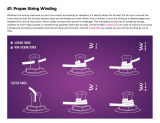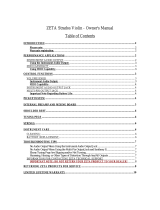Page is loading ...

How to Tune the Violin
The violin has four strings which are tuned in fifths. The scientific pitch of the strings from lowest to
highest is: G3, D4, A4, and E5.
Standard Violin Tuning - A4(Hz):440
String
Scientific
pitch
Helmholtz
pitch
Semitones from
Middle C
Frequency
(Hz)
G
G
3
g
-5
196.00
D
D
4
d′
2
293.66
A
A
4
a′
9
440.00
E
E
5
e′′
16
659.26
The violin is tuned in perfect fifths - each string is tuned an interval of a perfect fifth from the string
(or strings) next to it. The strings of the violin are tightened or loosened to produce the right note by
the pegs and the fine tuners. Some violins only have fine tuners on the E string, whereas others
have fine tuners on all 4 strings. If you buy a violin with only one fine tuner, you do have the option of
getting the other three fine tuners installed into the tailpiece by a luthier. As their name suggests, the
fine tuners are used for tuning the string if the string is off-pitch by a small interval of no more than
half a tone or so. When the string is out of tune by half a tone or more, then the pegs are used to
tune the note initially, with the fine tuner being used afterwards to make sure the note is exactly in
tune. Beginners are usually advised not to tune with the pegs unless absolutely necessary, in order
to avoid unnecessary string breakages. If you are beginning to tune from the peg, it is a good idea to
tune with a scientific tuner to make sure you are not over-tightening the string, however with most
low-end scientific tuners you will still have to be wary of tuning an octave too high or too low. Only
move the peg about a few millimeters at a time - you will be surprised at how significantly such a
small turn can affect the pitch of the string!
Tuning the Violin
When tuning any instrument, you should always tune from below the note, up. This prevents string
breakages and systematizes the process of tuning, so you eventually become more familiar with the
sound of a perfect, in-tune string. When tuning your violin, you should also always tune using the
fine tuners when possible (if you have them - most learner violins should have fine tuners). When a

fine tuner has been wound right down to the end of the screw, loosen the fine tuner all the way to the
end of the screw before carefully tightening the tuning peg. This way, you prevent the string from
being over-tightened.
When you are tuning your violin, play the note continuously with your bow and listen carefully to the
string as it tightens towards the desired pitch. Remember, you may need to stop to tune halfway
through a practice, especially if you are using new strings as they tend to stretch and may need
tightening from the peg multiple times per practice session for the first few days.
It is advisable to start by tuning the A string first, followed by the D, G then E strings. When you start
to become more familiar with the sound of the notes of the different strings, you can try tuning the
strings against each other - this is known as relative tuning (see 'Relative Tuning' section).
Relative Tuning
Relative tuning is a method of tuning the violin to itself and is a skill that requires a lot of practice and
time. In the beginning, some people find it easier to hear the true pitch of the note by closing their
eyes and tilting their left ear towards the F holes. You can try this too while you tune your violin. If
you have seen an orchestra play live, you may have seen the orchestra pass around the A. The A
string is played by the concertmaster (lead violinist) to make sure all members and sections of the
orchestra are tuned properly. As a violinist, you use the A that is 'passed' to you to tune your other
strings. To do this, you first make sure the A string is in tune, then play the A and D strings together,
listening for the perfect fifth interval to ring in tune. Then play the D and G strings together, followed
finally by the A and E. In order to tune like this you must have a good knowledge or what the strings
sound like, and what a perfect fifth sounds like too. Perfect fifths tend to sound very resonant, so you
may be able to tune this way if you listen carefully to the ringing sound, or by looking at how the
strings vibrate when you play them together. Start listening for these notes when you tune as a
beginner as it is a great skill to be able to internalize a set note and understand the exact perfect
frequency of the note by ear.
If you are a beginner, you should always start learning the violin with standard tuning as
standardized tuning gives you a better feel for the instrument and is easier to learn.

Common tuning Problems
The most common problem when tuning is pegs that slip out of place. To fix this problem try
unwinding the peg a round or two and then tighten the peg again, pressing the peg reasonably hard
into the peg box while turning the peg. Hopefully the peg will stick, and your violin will stay in tune!
If you have wound the fine tuners down to the nub and they cannot screw down any further, you can
fix this by first winding the fine tuner back as far as it will go without falling out. Then, tighten the
string at the peg, no more than a few millimeters at a time, until the pitch is just under the right note
you need. Then you can continue to tune the string at the fine tuner. This method of resetting the
fine tuners will prevent the string from breaking or wearing out due to excess tightening. If you find
that you over-turn the peg and the string then sounds higher than it is supposed to, you can unwind
the peg slightly to fix this as you will not be able to use the unwound fine tuner to tune down.
If you still have difficulty with slipping pegs or if you find that your fine tuners are hard to turn then
review the violin maintenance guide to read about what you can do to fix these problems.
Quick-Reference Tuning Tips
Tuning a violin is easy if you follow these simple tips:
Top Tip: Remember to always tune from below the note to prevent strings from breaking.
Use the fine tuners as much as possible to prevent string breakages. When they become
wound down to the nub, loosen them right the way up, use the peg to tighten the string to
just below the note, and use the fine tuners to tune the note up the rest of the way. Don't
over tighten the string at the peg as you will not be able to tune down with the loose fine
tuners.
Tune the A string first, followed by D, G then E strings. This is how orchestral violinists tune
their violins. It does help to get into a good tuning routine.
If you are using a tuner then try humming the right note from the tuner first, before you tune,
so you know exactly what note you are looking for. If you can't reach the note with your
voice, then just visualize humming it, this has much the same effect.
/



